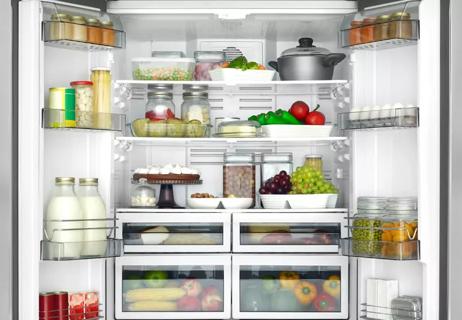"Better safe than sorry" applies here

When a wild storm rolls through town and knocks out your power, you might be fretting about your fridge full of food (among other things).
Advertisement
Cleveland Clinic is a non-profit academic medical center. Advertising on our site helps support our mission. We do not endorse non-Cleveland Clinic products or services. Policy
Of course, you just went to the grocery store! Will everything you just bought go bad?
First things first – resist the urge to open up the refrigerator and check on whatever’s in there. A refrigerator will stay cooler longer if it’s kept closed.
If you are going to open it, do so to move perishable things that freeze well – like fresh meat or poultry or leftovers from last night’s dinner – into the freezer, where they’ll stay at a safe temperature for longer.
If the power is out for less than four hours and you’ve been able to keep your paws off of the fridge, your grocery haul should be just fine.
However, if the power’s out for longer than that, or if you don’t know how long it’s been out, you’ll need to make some judgment calls.
According to the FDA and USDA, certain perishable foods that have been kept at a temperature above 40 degrees Fahrenheit for more than two hours should be thrown out. This includes meat, poultry, fish, soft cheeses, dairy products, eggs, cooked or cut produce, and cooked leftovers.
“In the warmer temperatures, bacteria that make you sick are more likely to grow,” says Lindsay Malone, MS, RD, CSO, LD, the Manager of Nutrition Services for the Center for Functional Medicine. “That could range from a stomach ache or running to the bathroom to a more serious foodborne illness.”
Advertisement
So when the power does come back on, check the temperature of your refrigerator. If it’s still below 40 degrees, you’re in the clear. If it’s above 40 degrees and you suspect it’s been that way for more than two hours, it’s time for a clean out.
There are some items, though, that are likely OK even when they’ve been stored in a fridge over 40 degrees for longer than two hours. These include:
If you’re unsure about how long the power has been out or about the temperature of your refrigerator, check to see if any of the food feels lukewarm to the touch. Whether the ice cubes in your freezer are still frozen can also give you an indication of how quickly the temperature has risen.
“But if you’re in doubt at all, throw it out – it’s just not worth the risk,” Malone says. Anyone whose immune system is weakened, like babies, seniors or people undergoing cancer treatment, are at a greater risk for illness and may require a higher level of caution, she adds.
As for your frozen goods? A full freezer will keep a safe temperature for up to two full days (or one day if it’s less full).
If you know a storm is about to blow in, there are a few things you can do in advance to protect your perishable items:
If you’re forced to throw out a lot of food after a storm, Malone recommends checking to see if your renters or homeowners insurance covers spoiled food. “For many people it does, so it’s worth calling to ask,” she says.
Advertisement
Learn more about our editorial process.
Advertisement

Color, texture, smell and expiration date all hold important clues

A guide to cooking or ordering in a restaurant

The great food storage debate

The short answer from a registered dietitian

When the guests go home, food clean up can be tricky

The short answer from a dietitian

CHANGE ADDED NOW Lorem ipsum dolor sit amet. Non voluptatem quibusdam qui nobis laborum in animi autem est veritatis temporibus quo impedit eius. Quo possimus quaerat sit odio omnis est commodi consequatur vel assumenda itaque. I ADDED THIS JUST NOW CHANGE

Warning: A popular TikTok hack to extend the life of avocados could lead to food poisoning

Type 2 diabetes isn’t inevitable with these dietary changes

Applying a hot or cold compress can help with pain